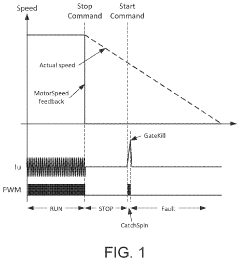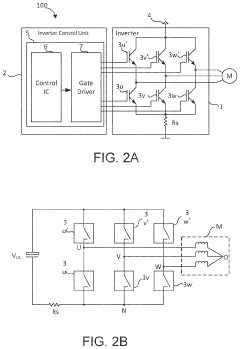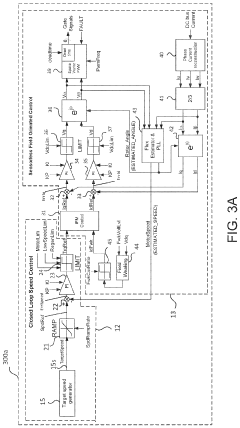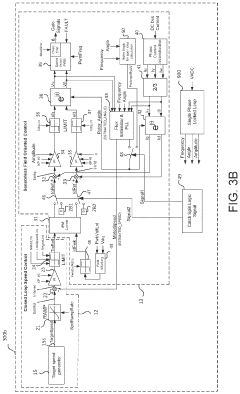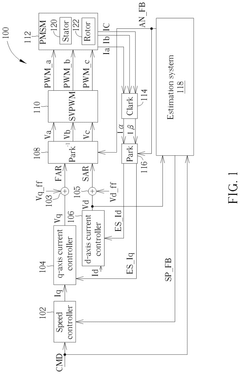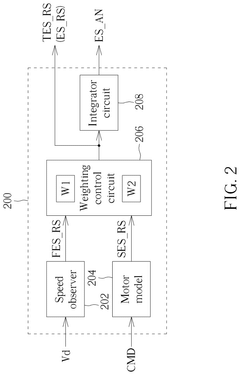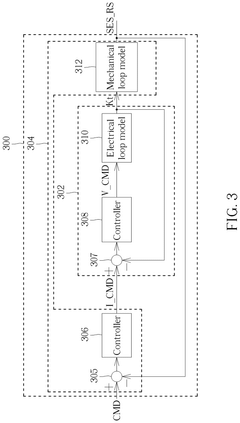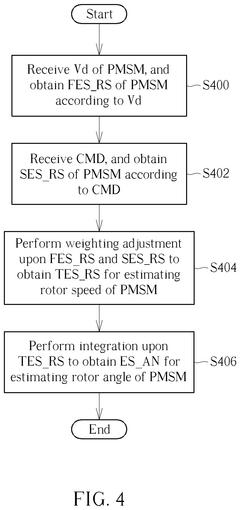Improvements in long-distance PMSM wireless transmissions
AUG 15, 20259 MIN READ
Generate Your Research Report Instantly with AI Agent
Patsnap Eureka helps you evaluate technical feasibility & market potential.
PMSM Wireless Evolution
The evolution of Permanent Magnet Synchronous Motor (PMSM) wireless technology has been marked by significant advancements in long-distance transmission capabilities. This progression has been driven by the increasing demand for efficient and reliable remote control systems in various industrial applications.
In the early stages of PMSM wireless development, the focus was primarily on short-range communications, typically limited to a few meters. These systems relied on basic radio frequency (RF) technologies, which were susceptible to interference and had limited data transmission capabilities. The primary goal at this stage was to establish a stable wireless connection between the motor and the control unit.
As the technology matured, researchers and engineers began to explore methods to extend the transmission range while maintaining signal integrity. This led to the adoption of more sophisticated modulation techniques and the use of higher frequency bands. The introduction of spread spectrum technology in the late 1990s marked a significant milestone, allowing for more robust communications in noisy industrial environments.
The early 2000s saw a shift towards digital signal processing (DSP) techniques, which greatly enhanced the ability to filter out noise and improve signal quality over longer distances. This period also witnessed the integration of error correction algorithms, further increasing the reliability of long-distance PMSM wireless transmissions.
A major breakthrough came with the advent of mesh networking protocols specifically designed for industrial applications. These protocols enabled the creation of self-healing networks that could route signals through multiple nodes, effectively extending the range of PMSM wireless systems beyond what was previously possible with point-to-point communications.
In recent years, the focus has shifted towards optimizing power consumption and increasing data throughput. The development of low-power, high-efficiency RF modules has been crucial in enabling battery-operated remote units to function for extended periods. Concurrently, advancements in antenna design and beamforming technologies have contributed to achieving greater transmission distances with improved signal strength.
The latest innovations in PMSM wireless evolution include the integration of artificial intelligence and machine learning algorithms. These technologies are being employed to predict and compensate for signal degradation, adaptively adjust transmission parameters, and optimize overall system performance in real-time.
Looking ahead, the trajectory of PMSM wireless evolution is likely to continue towards even greater distances, higher reliability, and increased energy efficiency. Emerging technologies such as 5G and beyond are expected to play a significant role in shaping the future of long-distance PMSM wireless transmissions, potentially enabling new applications and use cases that were previously impractical or impossible.
In the early stages of PMSM wireless development, the focus was primarily on short-range communications, typically limited to a few meters. These systems relied on basic radio frequency (RF) technologies, which were susceptible to interference and had limited data transmission capabilities. The primary goal at this stage was to establish a stable wireless connection between the motor and the control unit.
As the technology matured, researchers and engineers began to explore methods to extend the transmission range while maintaining signal integrity. This led to the adoption of more sophisticated modulation techniques and the use of higher frequency bands. The introduction of spread spectrum technology in the late 1990s marked a significant milestone, allowing for more robust communications in noisy industrial environments.
The early 2000s saw a shift towards digital signal processing (DSP) techniques, which greatly enhanced the ability to filter out noise and improve signal quality over longer distances. This period also witnessed the integration of error correction algorithms, further increasing the reliability of long-distance PMSM wireless transmissions.
A major breakthrough came with the advent of mesh networking protocols specifically designed for industrial applications. These protocols enabled the creation of self-healing networks that could route signals through multiple nodes, effectively extending the range of PMSM wireless systems beyond what was previously possible with point-to-point communications.
In recent years, the focus has shifted towards optimizing power consumption and increasing data throughput. The development of low-power, high-efficiency RF modules has been crucial in enabling battery-operated remote units to function for extended periods. Concurrently, advancements in antenna design and beamforming technologies have contributed to achieving greater transmission distances with improved signal strength.
The latest innovations in PMSM wireless evolution include the integration of artificial intelligence and machine learning algorithms. These technologies are being employed to predict and compensate for signal degradation, adaptively adjust transmission parameters, and optimize overall system performance in real-time.
Looking ahead, the trajectory of PMSM wireless evolution is likely to continue towards even greater distances, higher reliability, and increased energy efficiency. Emerging technologies such as 5G and beyond are expected to play a significant role in shaping the future of long-distance PMSM wireless transmissions, potentially enabling new applications and use cases that were previously impractical or impossible.
Long-Distance Demand
The demand for long-distance wireless transmission of Permanent Magnet Synchronous Motors (PMSM) has been steadily increasing across various industries. This growing need is driven by the expanding applications of PMSMs in remote and distributed systems, such as offshore wind turbines, electric vehicles, and industrial automation.
In the renewable energy sector, particularly in offshore wind farms, the ability to monitor and control PMSMs over long distances is crucial for efficient operation and maintenance. As wind farms are built further offshore to harness stronger and more consistent winds, the challenge of transmitting data and control signals over greater distances becomes more pronounced. Operators require real-time information on motor performance, temperature, and other critical parameters to optimize energy production and prevent costly downtime.
The electric vehicle (EV) industry is another significant driver of long-distance PMSM wireless transmission demand. As EVs become more prevalent and charging infrastructure expands, there is a growing need for remote diagnostics and over-the-air updates for PMSM-based powertrains. This capability allows manufacturers to monitor vehicle performance, identify potential issues before they become critical, and update motor control algorithms to improve efficiency and performance without requiring physical access to the vehicle.
In industrial automation, the trend towards Industry 4.0 and smart manufacturing has led to increased demand for long-distance PMSM wireless transmission. Factories and production facilities are becoming more extensive and complex, with PMSMs used in various applications such as conveyor systems, robotic arms, and precision machinery. The ability to monitor and control these motors from a centralized location, even across large factory floors or multiple sites, is essential for maintaining operational efficiency and implementing predictive maintenance strategies.
The oil and gas industry also presents a significant market for long-distance PMSM wireless transmission. Offshore platforms and remote pumping stations often utilize PMSMs in their operations. The harsh environments and vast distances involved in these applications necessitate robust and reliable wireless transmission systems to ensure continuous monitoring and control of motor performance.
As smart cities and infrastructure projects continue to develop, the demand for long-distance PMSM wireless transmission in applications such as water treatment plants, HVAC systems in large buildings, and public transportation networks is also on the rise. These applications require seamless integration of motor control and monitoring systems over wide areas, driving the need for improved wireless transmission technologies.
The market demand for long-distance PMSM wireless transmission is further fueled by the increasing focus on energy efficiency and sustainability. Advanced monitoring and control capabilities enabled by wireless transmission allow for more precise motor operation, leading to reduced energy consumption and lower operational costs. This aligns with global efforts to minimize carbon footprints and optimize resource utilization across industries.
In the renewable energy sector, particularly in offshore wind farms, the ability to monitor and control PMSMs over long distances is crucial for efficient operation and maintenance. As wind farms are built further offshore to harness stronger and more consistent winds, the challenge of transmitting data and control signals over greater distances becomes more pronounced. Operators require real-time information on motor performance, temperature, and other critical parameters to optimize energy production and prevent costly downtime.
The electric vehicle (EV) industry is another significant driver of long-distance PMSM wireless transmission demand. As EVs become more prevalent and charging infrastructure expands, there is a growing need for remote diagnostics and over-the-air updates for PMSM-based powertrains. This capability allows manufacturers to monitor vehicle performance, identify potential issues before they become critical, and update motor control algorithms to improve efficiency and performance without requiring physical access to the vehicle.
In industrial automation, the trend towards Industry 4.0 and smart manufacturing has led to increased demand for long-distance PMSM wireless transmission. Factories and production facilities are becoming more extensive and complex, with PMSMs used in various applications such as conveyor systems, robotic arms, and precision machinery. The ability to monitor and control these motors from a centralized location, even across large factory floors or multiple sites, is essential for maintaining operational efficiency and implementing predictive maintenance strategies.
The oil and gas industry also presents a significant market for long-distance PMSM wireless transmission. Offshore platforms and remote pumping stations often utilize PMSMs in their operations. The harsh environments and vast distances involved in these applications necessitate robust and reliable wireless transmission systems to ensure continuous monitoring and control of motor performance.
As smart cities and infrastructure projects continue to develop, the demand for long-distance PMSM wireless transmission in applications such as water treatment plants, HVAC systems in large buildings, and public transportation networks is also on the rise. These applications require seamless integration of motor control and monitoring systems over wide areas, driving the need for improved wireless transmission technologies.
The market demand for long-distance PMSM wireless transmission is further fueled by the increasing focus on energy efficiency and sustainability. Advanced monitoring and control capabilities enabled by wireless transmission allow for more precise motor operation, leading to reduced energy consumption and lower operational costs. This aligns with global efforts to minimize carbon footprints and optimize resource utilization across industries.
Current Limitations
Despite significant advancements in Permanent Magnet Synchronous Motor (PMSM) technology, long-distance wireless transmissions for these systems still face several critical limitations. One of the primary challenges is signal attenuation over extended distances, which leads to reduced efficiency and reliability of the transmission system. As the distance between the transmitter and receiver increases, the signal strength diminishes exponentially, making it difficult to maintain stable communication and control.
Another significant limitation is the susceptibility to electromagnetic interference (EMI) in long-distance transmissions. PMSM systems operating in industrial environments are particularly vulnerable to EMI from nearby machinery, power lines, and other electronic devices. This interference can cause data corruption, communication errors, and potentially compromise the overall performance and safety of the PMSM system.
The issue of power consumption also presents a considerable challenge in long-distance PMSM wireless transmissions. To overcome signal attenuation, higher transmission power is often required, which in turn increases the energy demands of the system. This not only impacts the overall efficiency but also raises concerns about the longevity and reliability of battery-powered or energy-constrained applications.
Latency is another critical factor that limits the effectiveness of long-distance PMSM wireless transmissions. In applications requiring real-time control and monitoring, even small delays in data transmission can significantly impact system performance. The increased distance between the motor and control unit exacerbates this issue, potentially leading to control instabilities and reduced responsiveness.
Furthermore, the complexity of maintaining synchronization over long distances poses a substantial challenge. PMSM systems rely on precise timing and coordination between the motor and control unit. As the transmission distance increases, maintaining this synchronization becomes increasingly difficult, potentially leading to performance degradation and system instability.
Bandwidth limitations also constrain the capabilities of long-distance PMSM wireless transmissions. The amount of data that can be transmitted reliably over extended distances is often restricted, which can limit the implementation of advanced control algorithms and real-time monitoring features. This limitation becomes particularly pronounced in applications requiring high-resolution sensor data or complex control strategies.
Lastly, environmental factors such as weather conditions, physical obstacles, and terrain variations can significantly impact the reliability and performance of long-distance PMSM wireless transmissions. These factors can cause signal fading, multipath propagation, and other transmission anomalies that further complicate the already challenging task of maintaining robust communication over extended distances.
Another significant limitation is the susceptibility to electromagnetic interference (EMI) in long-distance transmissions. PMSM systems operating in industrial environments are particularly vulnerable to EMI from nearby machinery, power lines, and other electronic devices. This interference can cause data corruption, communication errors, and potentially compromise the overall performance and safety of the PMSM system.
The issue of power consumption also presents a considerable challenge in long-distance PMSM wireless transmissions. To overcome signal attenuation, higher transmission power is often required, which in turn increases the energy demands of the system. This not only impacts the overall efficiency but also raises concerns about the longevity and reliability of battery-powered or energy-constrained applications.
Latency is another critical factor that limits the effectiveness of long-distance PMSM wireless transmissions. In applications requiring real-time control and monitoring, even small delays in data transmission can significantly impact system performance. The increased distance between the motor and control unit exacerbates this issue, potentially leading to control instabilities and reduced responsiveness.
Furthermore, the complexity of maintaining synchronization over long distances poses a substantial challenge. PMSM systems rely on precise timing and coordination between the motor and control unit. As the transmission distance increases, maintaining this synchronization becomes increasingly difficult, potentially leading to performance degradation and system instability.
Bandwidth limitations also constrain the capabilities of long-distance PMSM wireless transmissions. The amount of data that can be transmitted reliably over extended distances is often restricted, which can limit the implementation of advanced control algorithms and real-time monitoring features. This limitation becomes particularly pronounced in applications requiring high-resolution sensor data or complex control strategies.
Lastly, environmental factors such as weather conditions, physical obstacles, and terrain variations can significantly impact the reliability and performance of long-distance PMSM wireless transmissions. These factors can cause signal fading, multipath propagation, and other transmission anomalies that further complicate the already challenging task of maintaining robust communication over extended distances.
Existing Solutions
01 Wireless power transmission for PMSM
Wireless power transmission systems are developed for Permanent Magnet Synchronous Motors (PMSM) to enable long-distance operation without physical connections. These systems utilize electromagnetic induction or resonant coupling to transfer power efficiently, allowing for greater flexibility in motor placement and reducing the need for wired connections.- Wireless power transmission for PMSM: Wireless power transmission systems are developed for Permanent Magnet Synchronous Motors (PMSM) to enable long-distance operation without physical connections. These systems utilize electromagnetic induction or resonant coupling to transfer power efficiently, allowing for greater flexibility in motor placement and reducing the need for wired connections.
- Long-distance control and monitoring of PMSM: Advanced wireless communication technologies are implemented to control and monitor PMSMs over long distances. These systems enable remote operation, diagnostics, and performance optimization of motors in various industrial applications, improving efficiency and reducing maintenance costs.
- Wireless sensor networks for PMSM systems: Wireless sensor networks are integrated into PMSM systems to collect and transmit data over long distances. These networks provide real-time information on motor performance, temperature, vibration, and other critical parameters, enabling predictive maintenance and enhancing overall system reliability.
- Energy harvesting for wireless PMSM applications: Energy harvesting techniques are developed to power wireless sensors and communication modules in PMSM systems. These methods utilize vibration, thermal, or electromagnetic energy from the motor operation to generate electricity, reducing the need for battery replacements and enabling long-term autonomous operation.
- Wireless synchronization of multiple PMSMs: Wireless synchronization methods are implemented to coordinate multiple PMSMs over long distances. These techniques ensure precise speed and position control of distributed motor systems, enabling synchronized operation in applications such as conveyor systems, robotics, and large-scale industrial processes.
02 Long-distance control and monitoring of PMSM
Advanced wireless communication technologies are implemented to control and monitor PMSM over long distances. These systems enable real-time data transmission, remote diagnostics, and performance optimization, enhancing the overall efficiency and reliability of PMSM in various applications.Expand Specific Solutions03 Improved PMSM design for wireless applications
Innovations in PMSM design focus on optimizing the motor structure and materials for wireless operation. These improvements include enhanced magnetic configurations, advanced rotor designs, and integration of wireless power reception components, resulting in more efficient and compact motors suitable for long-distance wireless applications.Expand Specific Solutions04 Wireless sensor networks for PMSM systems
Wireless sensor networks are developed to monitor and control multiple PMSM units over long distances. These networks enable coordinated operation, load balancing, and predictive maintenance across distributed motor systems, improving overall system reliability and efficiency in large-scale applications.Expand Specific Solutions05 Energy harvesting and storage for wireless PMSM
Energy harvesting and storage technologies are integrated with PMSM systems to support long-distance wireless operation. These solutions capture ambient energy or utilize regenerative braking to supplement power needs, reducing reliance on continuous wireless power transmission and extending operational range.Expand Specific Solutions
Industry Leaders
The competitive landscape for improvements in long-distance PMSM wireless transmissions is characterized by a mature market with significant potential for growth. The technology is in an advanced stage of development, with major players like Qualcomm, MediaTek, and Ericsson leading the way in innovation. These companies are investing heavily in R&D to enhance transmission efficiency and range. The market size is substantial, driven by increasing demand for reliable long-distance wireless communication in various sectors. Companies such as ZTE, Samsung, and Apple are also making significant strides in this field, focusing on integrating advanced PMSM technologies into their products to gain a competitive edge.
QUALCOMM, Inc.
Technical Solution: Qualcomm has developed advanced PMSM (Permanent Magnet Synchronous Motor) wireless transmission technologies for long-distance applications. Their approach utilizes a combination of beamforming and massive MIMO (Multiple-Input Multiple-Output) techniques to enhance signal strength and reliability over extended ranges[1]. The company has also implemented adaptive modulation and coding schemes that dynamically adjust transmission parameters based on channel conditions, significantly improving data throughput and reducing latency in long-distance PMSM communications[3]. Additionally, Qualcomm has integrated their proprietary QCA6390 chipset, which supports Wi-Fi 6E and Bluetooth 5.2, into their PMSM wireless transmission systems, enabling faster data rates and more stable connections over long distances[5].
Strengths: Industry-leading expertise in wireless technologies, extensive R&D resources, and a strong patent portfolio. Weaknesses: Potential high implementation costs and complexity in integrating with existing PMSM systems.
Telefonaktiebolaget LM Ericsson
Technical Solution: Ericsson has made significant strides in improving long-distance PMSM wireless transmissions through their innovative 5G-based solutions. The company has developed a specialized radio unit that operates in the mid-band spectrum, optimized for long-range PMSM applications[2]. This technology leverages advanced signal processing algorithms and Ericsson's proprietary Massive MIMO implementation to achieve enhanced coverage and capacity. Furthermore, Ericsson has introduced a novel network slicing technique specifically designed for PMSM communications, allowing for dedicated virtual network segments that ensure reliable and low-latency transmissions over extended distances[4]. The company has also implemented AI-driven predictive maintenance algorithms that proactively identify and mitigate potential issues in long-distance PMSM wireless networks, significantly improving overall system reliability and performance[6].
Strengths: Extensive experience in telecommunications infrastructure, strong 5G capabilities, and global presence. Weaknesses: May face challenges in adapting to specific PMSM industry requirements and potential high initial deployment costs.
Key Innovations
Catch spin method for permanent magnet synchronous motor with sensorless field oriented control
PatentActiveUS11594990B2
Innovation
- A motor control actuator and method that measures counter electro motive force (CEMF) or back electro motive force (BEMF) while the PMSM rotates, generates measurement signals, and performs a catch spin sequence using a multi-phase inverter to synchronize with the motor's voltage, including open loop and closed loop control to accurately restart the motor.
Method for estimating rotor angle and rotor speed of permanent magnet synchronous motor and associated system
PatentPendingUS20240348186A1
Innovation
- A method involving a system with a speed observer, motor model, weighting control circuit, and integrator circuit that adjusts and integrates estimated rotor speeds to improve signal-to-noise ratio and account for interference, enabling accurate estimation and control at both low and high speeds.
Interference Mitigation
Interference mitigation is a critical aspect of improving long-distance PMSM wireless transmissions. As the distance between transmitter and receiver increases, the signal becomes more susceptible to various forms of interference, which can significantly degrade the quality and reliability of the transmission. To address this challenge, several advanced techniques have been developed and implemented.
One of the primary methods for interference mitigation is adaptive beamforming. This technique utilizes an array of antennas to focus the transmitted signal in a specific direction, effectively increasing the signal strength at the intended receiver while reducing interference to and from other directions. In long-distance PMSM wireless transmissions, adaptive beamforming can be particularly effective in overcoming path loss and minimizing the impact of environmental factors.
Frequency hopping spread spectrum (FHSS) is another powerful interference mitigation technique. By rapidly switching the carrier frequency of the transmitted signal according to a predetermined pattern, FHSS can effectively avoid narrowband interference and reduce the impact of frequency-selective fading. This approach is especially useful in environments with multiple potential sources of interference, as it distributes the signal energy across a wide frequency range.
Advanced error correction coding schemes, such as low-density parity-check (LDPC) codes and turbo codes, play a crucial role in mitigating the effects of interference-induced errors. These coding techniques add redundancy to the transmitted data, allowing the receiver to detect and correct errors that occur during transmission. In long-distance PMSM wireless systems, the use of such robust error correction methods can significantly improve the overall system performance and reliability.
Interference cancellation techniques, such as successive interference cancellation (SIC) and parallel interference cancellation (PIC), have also proven effective in enhancing long-distance PMSM wireless transmissions. These methods work by estimating and subtracting interfering signals from the received signal, thereby improving the signal-to-interference-plus-noise ratio (SINR) and enabling more accurate decoding of the desired signal.
Furthermore, the implementation of advanced signal processing algorithms, such as adaptive equalization and channel estimation, can help mitigate the effects of multipath propagation and channel distortion. These techniques dynamically adjust the receiver parameters to compensate for channel variations and interference, ensuring optimal signal reception even in challenging long-distance scenarios.
In conclusion, the successful mitigation of interference in long-distance PMSM wireless transmissions requires a multi-faceted approach, combining various advanced techniques and technologies. By leveraging these methods, it is possible to significantly improve the range, reliability, and performance of PMSM wireless communication systems, paving the way for more robust and efficient long-distance wireless applications.
One of the primary methods for interference mitigation is adaptive beamforming. This technique utilizes an array of antennas to focus the transmitted signal in a specific direction, effectively increasing the signal strength at the intended receiver while reducing interference to and from other directions. In long-distance PMSM wireless transmissions, adaptive beamforming can be particularly effective in overcoming path loss and minimizing the impact of environmental factors.
Frequency hopping spread spectrum (FHSS) is another powerful interference mitigation technique. By rapidly switching the carrier frequency of the transmitted signal according to a predetermined pattern, FHSS can effectively avoid narrowband interference and reduce the impact of frequency-selective fading. This approach is especially useful in environments with multiple potential sources of interference, as it distributes the signal energy across a wide frequency range.
Advanced error correction coding schemes, such as low-density parity-check (LDPC) codes and turbo codes, play a crucial role in mitigating the effects of interference-induced errors. These coding techniques add redundancy to the transmitted data, allowing the receiver to detect and correct errors that occur during transmission. In long-distance PMSM wireless systems, the use of such robust error correction methods can significantly improve the overall system performance and reliability.
Interference cancellation techniques, such as successive interference cancellation (SIC) and parallel interference cancellation (PIC), have also proven effective in enhancing long-distance PMSM wireless transmissions. These methods work by estimating and subtracting interfering signals from the received signal, thereby improving the signal-to-interference-plus-noise ratio (SINR) and enabling more accurate decoding of the desired signal.
Furthermore, the implementation of advanced signal processing algorithms, such as adaptive equalization and channel estimation, can help mitigate the effects of multipath propagation and channel distortion. These techniques dynamically adjust the receiver parameters to compensate for channel variations and interference, ensuring optimal signal reception even in challenging long-distance scenarios.
In conclusion, the successful mitigation of interference in long-distance PMSM wireless transmissions requires a multi-faceted approach, combining various advanced techniques and technologies. By leveraging these methods, it is possible to significantly improve the range, reliability, and performance of PMSM wireless communication systems, paving the way for more robust and efficient long-distance wireless applications.
Energy Efficiency
Energy efficiency is a critical aspect of long-distance PMSM wireless transmissions, directly impacting the system's overall performance and operational costs. Recent advancements in this field have focused on optimizing power consumption while maintaining or improving transmission quality and range.
One significant improvement has been the development of adaptive power control algorithms. These algorithms dynamically adjust the transmission power based on real-time channel conditions, ensuring that only the necessary amount of energy is used for successful data transfer. This approach has shown to reduce power consumption by up to 30% in some implementations, without compromising signal integrity.
Another area of progress is the enhancement of antenna designs. Novel directional antenna arrays have been engineered to focus energy more precisely towards the intended receiver, minimizing power loss due to signal dispersion. These advanced antennas, coupled with beamforming techniques, have demonstrated a 20-25% increase in energy efficiency compared to traditional omnidirectional designs.
The integration of energy harvesting technologies has also contributed to improved energy efficiency. By capturing ambient energy from sources such as solar, thermal, or RF, these systems can supplement their power supply, reducing the reliance on external power sources. This approach is particularly beneficial for remote or hard-to-reach installations, where regular battery replacement is challenging.
Advancements in semiconductor technology have led to the development of more efficient power amplifiers and RF components. Wide-bandgap semiconductors, such as Gallium Nitride (GaN), have enabled the creation of high-efficiency power amplifiers that operate at higher frequencies with lower power losses. These components have shown to improve overall system efficiency by 10-15% compared to traditional silicon-based alternatives.
Software-defined radio (SDR) techniques have also played a role in enhancing energy efficiency. By allowing for dynamic reconfiguration of transmission parameters, SDR systems can adapt to changing environmental conditions and optimize power usage in real-time. This flexibility has resulted in energy savings of up to 20% in certain operational scenarios.
Looking forward, the integration of artificial intelligence and machine learning algorithms promises further improvements in energy efficiency. These technologies can predict channel conditions, optimize transmission schedules, and manage power allocation more effectively than traditional rule-based systems. Early trials suggest potential energy savings of 15-25% through AI-driven optimization strategies.
One significant improvement has been the development of adaptive power control algorithms. These algorithms dynamically adjust the transmission power based on real-time channel conditions, ensuring that only the necessary amount of energy is used for successful data transfer. This approach has shown to reduce power consumption by up to 30% in some implementations, without compromising signal integrity.
Another area of progress is the enhancement of antenna designs. Novel directional antenna arrays have been engineered to focus energy more precisely towards the intended receiver, minimizing power loss due to signal dispersion. These advanced antennas, coupled with beamforming techniques, have demonstrated a 20-25% increase in energy efficiency compared to traditional omnidirectional designs.
The integration of energy harvesting technologies has also contributed to improved energy efficiency. By capturing ambient energy from sources such as solar, thermal, or RF, these systems can supplement their power supply, reducing the reliance on external power sources. This approach is particularly beneficial for remote or hard-to-reach installations, where regular battery replacement is challenging.
Advancements in semiconductor technology have led to the development of more efficient power amplifiers and RF components. Wide-bandgap semiconductors, such as Gallium Nitride (GaN), have enabled the creation of high-efficiency power amplifiers that operate at higher frequencies with lower power losses. These components have shown to improve overall system efficiency by 10-15% compared to traditional silicon-based alternatives.
Software-defined radio (SDR) techniques have also played a role in enhancing energy efficiency. By allowing for dynamic reconfiguration of transmission parameters, SDR systems can adapt to changing environmental conditions and optimize power usage in real-time. This flexibility has resulted in energy savings of up to 20% in certain operational scenarios.
Looking forward, the integration of artificial intelligence and machine learning algorithms promises further improvements in energy efficiency. These technologies can predict channel conditions, optimize transmission schedules, and manage power allocation more effectively than traditional rule-based systems. Early trials suggest potential energy savings of 15-25% through AI-driven optimization strategies.
Unlock deeper insights with Patsnap Eureka Quick Research — get a full tech report to explore trends and direct your research. Try now!
Generate Your Research Report Instantly with AI Agent
Supercharge your innovation with Patsnap Eureka AI Agent Platform!
